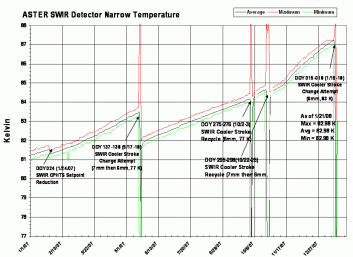|
Capabilities
ASTER User
Advisory
Change in Status Alert - September 1, 2008
ASTER SWIR bands continue to be adversely impacted by an anomalously high
SWIR detector temperature. Although the ASTER team continues to focus on
this situation, no improvement is anticipated in the next few weeks. Users
are advised that ASTER SWIR data acquired from late April 2008 to the
present exhibit anomalous saturation of values and anomalous striping.
Cloud cover assessment and TIR location accuracy have also been affected.
Earlier archived data conform to mission specifications.
Additional advisories will continue to be provided.
ASTER User
Advisory
Change in Status Alert - May 7, 2008
Users are advised that ASTER SWIR data acquired in late April
and early May 2008 exhibit anomalous saturation of values and anomalous
striping. Cloud cover assessment and TIR location accuracy have also been
affected by the present situation.
Since January 2008, SWIR performance has been stable and data
quality has been nominal. On April 23, 2008, the SWIR detector temperature rose
precipitously, and SWIR Bands 5-9 saturated.
In an attempt to lower the SWIR detector temperature and improve
data quality, the ASTER Team plans to commence another SWIR recycling procedure
on May 7, 2008. If successful, stable SWIR performance and nominal data quality
will be restored.
The data quality impacts referenced in the April 9, 2008 alert
still apply for the periods specified.
Additional advisories will continue to be provided.
ASTER User
Advisory
February 5, 2008
This advisory is written to users of ASTER SWIR data to alert them to the
fact that some anomalous saturation of values has been observed in ASTER Bands 5
through 9 since May 2007. This problem is attributed to an increase in ASTER SWIR detector temperature believed to be caused by increased thermal resistance
in the SWIR cryocooler. VNIR and TIR bands are unaffected by this problem.
The slow increase in SWIR detector temperature did not become a problem until
early in 2007, and it did not really affect data quality until the detector
temperature exceeded 83ºK. Figure 1 shows the trend in SWIR detector temperature
for the past year. Note that the detector temperature first exceeded 83ºK on about May 1, 2007.
Following that date, four attempts have been made to lower the detector
temperature by recycling the cryocooler, including increasing the stroke length
of the cryocooler piston. The first attempt in May succeeded in reducing the
temperature to 82ºK, but the temperature soon began to increase again, exceeding
83ºK in late July. Second and third attempts to reduce the SWIR detector
temperature essentially failed in October. However, a fourth attempt in
mid-January, 2008 succeeded in reducing the SWIR detector temperature to 83ºK.
Since that date the SWIR detector temperature has remained stable at 83ºK.
|

Figure 1. ASTER SWIR detector narrow temperature trend. Maximum (red),
average (black), and minimum (green) lines are plotted. |
|
As long as the detector temperature remains at 83ºK, little or no degradation of
ASTER SWIR data is expected. However, users are advised that for ASTER SWIR data
collected between late May 2007 and late January 2008, the SWIR detector
temperature exceeded 83ºK, except for about six weeks in June and July. SWIR
data acquired during these periods may exhibit anomalous saturation of values,
particularly at high sun angles and for materials that are highly reflective in
the SWIR bands.
Figure 2 shows an example of SWIR saturation in an extremely bright desert
scene acquired over northern Africa in August 2007, when the detector
temperature was at about 83.5ºK. Saturation is especially prevalent in Bands 5,
6, and 7. Saturated pixels with DN = 255 are displayed in black. All other
colors are unsaturated pixels.
|

Figure 2. SWIR saturation example. August 24, 2007 Africa observation. Pixels
with DN = 255 are colored black. |
|
|